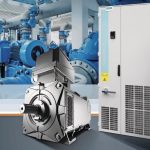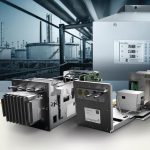The productivity and profitability of plants in the process industries hinge on reliable, trouble-free and energy-efficient operation. At the Achema 2015 trade fair Siemens will demonstrate at its 1300 square metre booth how companies in the process industry can boost their efficiency and productivity by using integrated solutions.
Author Daniela Held Editor, cpp chemical plants & processes
Based on the slogan “From Integrated Engineering to Integrated Operation – Discover the Potential of Digitalization” Siemens is focusing on the topic of digitalisation at the Achema 2015 trade fair. “On the basis of our existing range of products and services for electrification and automation, we are promoting digitalisation within the process industry. This is because digitalisation permits the integration of individual process steps over the entire plant lifecycle – from engineering and operation, through to continuous optimisation. And as a reliable partner, we are supporting our customers all the way,” explained Eckard Eberle, CEO of the Process Automation Business Unit and stand manager of the Siemens booth. “In order to implement the Industrie 4.0 project in the process industry, we are focusing on three action fields: the digital plant, modularisation and optimised production.”
Integrated data landscape
One of the most important objectives on the road to digital plants is the creation of an integrated data landscape. Siemens already provides seamless data across all phases of the lifecycle: from engineering with the Comos CAE tool and commissioning using the Simit simulation platform to operation based on the Simatic PCS 7 process control system and XHQ Operations Intelligence for real-time corporate decisions. The benefits are greater transparency and reliability as well as a faster time to market. Virtual commissioning using the Simit Simulation Framework software, for example, means plants can be put into service in less than half the normal time while simultaneously improving operational reliability.
XHQ Operations Intelligence is another example of how smart data can be generated from big data. This Siemens software captures data from a wide variety of sources, brings it together efficiently in one management cockpit and helps users make well informed decisions. Operating costs can be cut by as much as 8 % as a result.
Using data based services such as control performance analytics, process and status data from closed-loop control systems can be analysed in order to define measures for optimi-sation. Comos MRO (Maintenance, Repair & Overhaul) makes it possible to handle all the administration, planning and organisation of operation and maintenance work, including plant documentation, in a single system. This means that any changes to the plant due to maintenance processes are also immediately available in the engineering data.
Integrated drive components
At the Frankfurt exhibition, Siemens will show how Simotics motors and Sinamics converters create an integrated drive system (IDS) that achieves process-optimised, energy-saving and low-noise operation of pumps, fans and compressors. Siemens offers the integrated drive system comprising a Simotics XP motor and a Sinamics G180 converter specifically for applications in hazardous areas. The system is integrated into the Simatic PCS 7 process control system via the Advanced Process Library (APL) with motor blocks and faceplates. The Simotics XP motor is designed to cope with zones 1 and 2 (gas and dust) and together with the Sinamics G180 converter forms an optimally matched and certified system, with a motor that is suitable and certified for converter and DOL operation.
As far as the customer is concerned, integrating the motor and converter into the PCS 7 means greater efficiency, planning security and operating reliability. The drive components can be integrated easily into the automation environment. Data and information on the status of electronic and mechatronic system components can be accessed quickly and conveniently through simple diagnostics and maintenance in the PCS 7 Maintenance Station (MS).
Industry-specific solutions
The Siemens exhibit will showcase integrated, industry-specific solutions as two particular highlights: a modular Chem-API batch plant for the pharmaceutical industry will demonstrate the seamless interaction of engineering and production planning software with automation systems and process instruments in a hygienic version. Its special features include a new paperless manufacturing solution. The production data is captured and documented electronically, considerably speeding up the process of executing, checking and releasing pharmaceutical production processes and batch protocols. The second highlight – a separation column used in chemical production – will illustrate the benefits of seamless data communication. This not only makes production more transparent and more efficient, it also improves plant availability and process reliability with redundancy concepts and integrated safety functions.
Modular analytical solutions
Ultramat 7 and Calomat 7 are two new analyser modules from Siemens for its Siprocess GA700 gas analysis system. Together with the Oxymat 7 module which is already available, they allow flexible analytical solutions to be configured, for example for measuring oxygen, hydrogen, noble gases or infrared-active components such as carbon monoxide and dioxide. The modular design of the Siprocess GA700 enables fast installation and replacement using the plug and measure principle. Depending on the configuration, the units can be used at temperatures of up to 50°C.
The Siprocess GA700 comprises a base unit into which one or two modules can be integrated. These modules form the actual analyser unit which provides the sensor-related electronics, including the evaluation software as well as the process connections. The influence of interfering gases can then be measured and mutually offset. The modular architecture gives greater flexibility when it comes to upgrades or retrofits since the mod-ules are automatically recognised and configured.
In addition to the Oxymat 7 module for oxygen measurements, the Calomat 7 can now be used to carry out quantitative determinations of hydrogen and noble gases in binary or quasi-binary gas mixtures. Depending on the param-eter settings, the measuring range for hydrogen is 0 to 0.5 %, 0 to 100 % or 95 to 100 %. The module is therefore equally suited both for pure or protective gas monitoring and for determining the hydrogen content of blast furnace or converter gases.
The Ultramat 7 module carries out highly selective measurements of up to two infrared-active components such as carbon monoxide and dioxide. The Siprocess GA700 can be configured, parameterised and started up using the Simatic PDM (Process Device Manager). The software tool also incorporates diagnostic and maintenance functions for the gas analyser.
Hall 11.0, Booth C3
cpp-net.com/0215436
Share:









